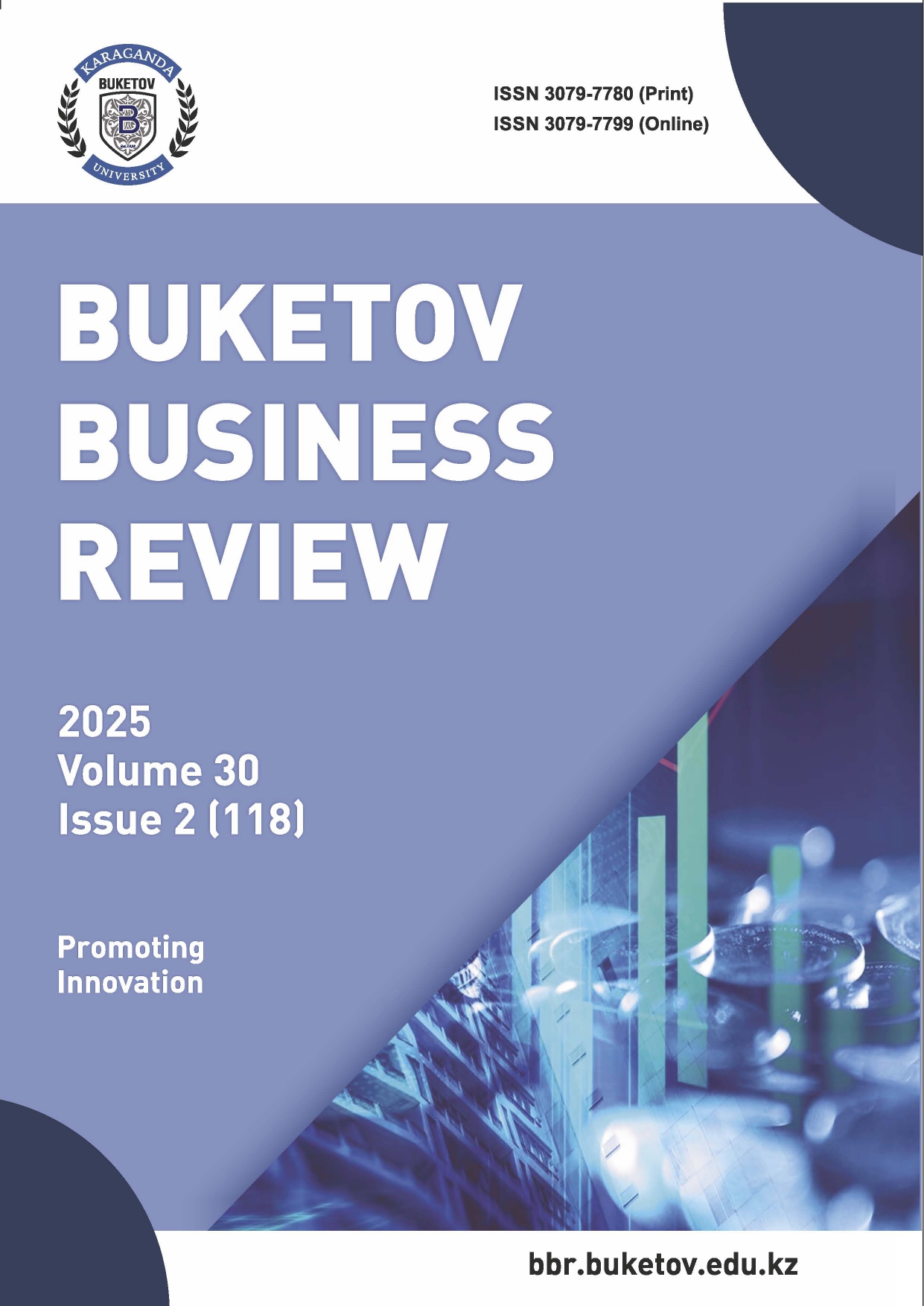From Household Duties to Innovation: The Role of Gender Norms in Women’s Economic Participation
DOI:
https://doi.org/10.31489/2025ec2/41-53Keywords:
Innovation, Patrilocality hypothesis, Household structure, Women’s labour, Gender roles, Cultural norms, Econometric analysisAbstract
This study examines how cultural norms and household structure affect women’s participation in the labour force and their capacity to contribute to innovative activity, emphasizing patrilocality theory in Kyrgyzstan. According to the the ory, women who reside with their husband’s family are expected to spend more time on household duties and may be less likely to participate in income-generating and innovative activities outside the home. Econometric analysis uses data from the 2019 Life in Kyrgyzstan (LiK) panel survey. The Tobit model analyses the relationship between women’s living arrangements, labour force participation and earnings. The analysis reveals that, other things being equal, women earn lower wages if they have many household responsibilities; however, this does not mean that women in patrilocal living arrangements have low earnings. It also shows that education, location, and other socio-economic factors are most important in determining the rate of women’s economic participation and the innovation potential. Moreover, household decision-making power and cultural expectations are most likely to affect women’s opportunities for labour market participation. The study finds that resolving gender inequalities in domestic responsibilities and power to make decisions is crucial to unlock the potential of women in innovation for the economy. The study contributes to the exist ing literature as the first empirical analysis of these dynamics in CIS countries and as policy recommendations to pro mote gender equity and economic growth.
References
Anderson, S. (2007). The economics of dowry and brideprice. Journal of Economic Perspectives, 21(4), 151–174. Retrieved from The Economics of Dowry and Brideprice — American Economic Association
Arabsheibani. G.R., Kudebayeva A., & Mussurov, A. (2021). A note on bride kidnapping and labour supply behaviour of Kyrgyz women. Economic Systems, 45(4), 100885. https://doi.org/10.1016/j.ecosys.2021.100885
Becker, C.M., Mirkasimov, B., & Steiner, S. (2017). Forced marriage and birth outcomes. Demography, 54(4), 1401–1423. https://doi.org/10.1007/s13524-017-0591-1
Chen, Y., & Mace, R. (2023). Women work harder than men — our anthropological study reveals why. The Conversation. Retrieved from Women work harder than men — our anthropological study reveals why (theconversation.com)
Chen, Y., Ge, E., Zhou, L., Du, J., & Mace, R. (2023). Sex inequality is driven by dispersal. Current Biology 33(3), 464–473. https://doi.org/10.1016/j.cub.2022.12.027
Corno, L., Hildebrandt, N., & Voena, A. (2020). Age of marriage, weather shocks, and the direction of marriage payments. Econometrica, 88(3), 879–915. https://doi.org/10.3982/ECTA15505
Duxbury, L.E., & Higgins, C.A. (1991). Gender differences in work-family conflict. Journal of applied psychology, 76(1), 60. https://psycnet.apa.org/doi/10.1037/0021-9010.76.1.60
Eissa, N., & Hoynes, H.W. (2004). Taxes and the labour market participation of married couples: the earned income tax credit. Journal of Public Economics, 88(9-10), 1931–1958. https://doi.org/10.1016/j.jpubeco.2003.09.005
Farré, L., Jofre-Monseny, J., & Torrecillas, J. (2020). Commuting time and the gender gap in labor market participation. IZA Discussion Papers, 13213. https://dx.doi.org/10.2139/ssrn.3685824
Field, E., & Ambrus, A. (2008). Early marriage, age of menarche, and female schooling attainment in Bangladesh. Journal of Political Economy, 116(5), 881–930. Retrieved from Early Marriage, Age of Menarche, and Female Schooling Attainment in Bangladesh | Journal of Political Economy: Vol 116, No 5
Flèche, S., Lepinteur, A., & Powdthavee, N. (2020). Gender norms, fairness and relative working hours within households. Labour Economics, 65, 101866. https://doi.org/10.1016/j.labeco.2020.101866
Foster, G., & Stratton, L.S. (2018). Do significant labour market events change who does the chores? Paid work, housework, and power in mixed-gender Australian households. Journal of Population Economics, 31, 483–519. https://doi.org/10.1007/s00148-017-0667-7
Haq, M., Ali, A., Ahmad, I., & Sajjad, W. (2023). Religiosity, gender attitudes, and women’s labour market participation. Nurture, 17(1), 29–39. https://doi.org/10.55951/nurture.v17i1.147
Heath, R., & Tan, X. (2020). Intrahousehold bargaining, female autonomy, and labour supply: Theory and evidence from India. Journal of the European Economic Association, 18(4), 1928–1968. https://doi.org/10.1093/jeea/jvz026
Karymshakov, K., & Sulaimanova, B. (2017). Migration impacts left-behind women’s labour participation and time-use: Evidence from Kyrgyzstan (No. 2017/119). WIDER working paper. https://doi.org/10.35188/UNU-WIDER/2017/343-1
Kimmel, J. (1998). Child care costs are a barrier to employment for single and married mothers. Review of Economics and Statistics, 80(2), 287–299. https://doi.org/10.1162/003465398557384
Kolpashnikova, K. (2016). Housework in Canada: Uneven convergence of the gender gap in domestic tasks, 1986–2010. Doctor’s thesis. Vancouver, BC: University of British Columbia. https://doi. org/10.14288/1.0340502
Kolpashnikova, K. (2018). American househusbands: New time use evidence of gender display, 2003–2016. Social Indicators Research, 140(3), 1259–1277. https://doi. org/10.1007/s11205-017-1813-z
Kolpashnikova, K., & Kan, M.-Y. (2020). Gender gap in housework: Couples’ data analysis in Kyrgyzstan. Journal of Comparative Family Studies, 51(2): 154-187. Retrieved from https://utppublishing.com/doi/full/10.3138/jcfs.51.2.04
Kovaleva, I., & Taylor, L. (2023a). Why Do Women Work Harder Than Men? Testing the Patrilocality Hypothesis. Qual Prim Care, 31, 31. Retrieved from https://www.researchgate.net/profile/Irina-Kovaleva-3/publication/378005014
Kovaleva, I., & Taylor, L. (2023b). A model of why women work harder than men. https://doi.org/10.21203/rs.3.rs-3191790/v1
Kovaleva, I., Taylor, L., Pech, G., & Madumarov, E. (2025). What household structure encourages innovation? Comparative analysis of a case study of female labor in Kyrgyzstan and Kazakhstan. BUKETOV BUSINESS REVIEW, 11730(1), 30–42.
Landmann, A., Seitz, H., & Steiner, S. (2018). Patrilocal residence and female labor supply: evidence from Kyrgyzstan. Demography, 55(6), 2181–2203. https://doi.org/10.1007/s13524-018-0724-1
Micheletti, A.J.C., Ruxton, G.D., & Gardner, A. (2020). The demography of human warfare can drive sex differences in altruism. Evolutionary Human Sciences, 2, 1–15. https://doi.org/10.1017/ehs.2020.5
Moreno-Colom, S. (2017). The gendered division of housework time: Analysis of time use by type and daily frequency of household tasks. Time and Society, 26(1), 3–27. https://doi.org/10.1177/0961463X15577269
Downloads
Published
How to Cite
Issue
Section
License
Copyright (c) 2025 BUKETOV BUSINESS REVIEW

This work is licensed under a Creative Commons Attribution-NonCommercial-NoDerivatives 4.0 International License.



